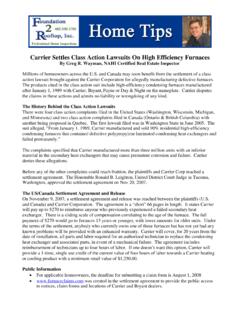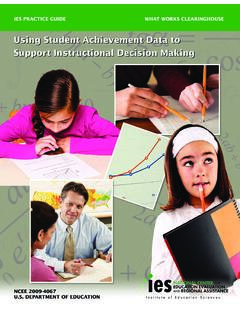Transcription of EvidenceBased Strategies for Improving the Reading ...
1 Learning Disabilities Research & Practice,27(2), 79 89C 2012 The Division for Learning Disabilities of the Council for Exceptional ChildrenEvidence-Based Strategies for Improving the Reading Comprehension ofSecondary Students: Implications for Students with Learning DisabilitiesSilvana M. R. Watson, Robert A. Gable, Sabra B. Gear, Kimberly C. HughesOld Dominion UniversityReading comprehension is a complex skill that places significant demands on students, be-ginning with elementary school and continuing through the secondary grades. In this article,we provide an overview of possible factors associated with problems in Reading comprehen-sion among secondary students with learning disabilities. Discussion underscores the fact thatcomprehension problems are evidenced by a heterogeneous group of students. We argue thatit is important for teachers to align an intervention with a specific area of difficulty ( ,teaching prefixes and suffixes to increase Reading vocabulary).
2 We highlight research-basedinterventions advocated by the National Reading Panel and offer ways that teachers can matchspecific Strategies with the individual needs of students with problems in Reading comprehen-sion. Finally, we emphasize that whatever strategy is selected, it should be structured, explicit,scaffolded, and intense (Williams et al., 2005). Reading comprehension has been defined as the process thatexcerpts and, at the same time, creates meaning by havingthe student interact and be involved with written language(Shanahan et al., 2010). According to Durkin (1993), it hascome to be known as the essence of Reading . Reading com-prehension requires the reader to make connections with thetext and, in addition, to the reader s prior knowledge (van deBroek, Rapp, & Kendeau, 2005). It is a complex task that in-volves a range of language and cognitive processes and skillsthat students must master in order to make sense of writ-ten text (Fletcher, Lyon, Fuchs, & Barnes, 2007; Oakhill &Cain, 2007; Swanson, Howard, & S aez, 2006).
3 Not surpris-ingly, many students identified as having learning disabilities(LD) experience problems in the area of Reading compre-hension (Klingner, Vaughn, & Boardman, 2007; Swanson,Howard, & S aez, 2007). These students struggle to constructmeaning from written text, connect meaning to words, makeinferences, draw conclusions, recall and summarize informa-tion, and actively monitor their comprehension (Catts, Adlof,& Weismer, 2006; Jitendra, Hoppes, & Xin, 2000; Rappet al., 2007; Williams, 2005). These challenges are not nec-essarily a consequence of problems in decoding; rather, theyoften are a result of limited working memory (WM) capac-ity, inhibitory problems, prior knowledge, misconceptions,text structure knowledge, planning, and language difficulties(Adlof, Catts, & Lee, 2010; Borella, Carretti, & Pelegrina,2010; Kendeau & van den Broek, 2007; Locascio, Mahone,Eason, & Cutting, 2010; Swanson, Kehler, & Jerman, 2010;Taylor & Williams, 1983).
4 In sum, students with readingcomprehension problems constitute a diverse group of stu-dents who have different profiles across a range of literacytasks and grade levels (Floyd, Bergeron, & Alfonso, 2006;Gajria, Jitendra, Sood, & Sacks, 2007).Requests for reprints should be sent to Silvana M. R. Watson, OldDominion University. Electronic mail may be sent to what follows, we briefly discuss the nature of read-ing comprehension problems, examine skills that are es-sential to text comprehension, and highlight the conse-quences of not being able to understand what is read. Weassert that Reading comprehension is a multifaceted pro-cess and that students need multiple tools to understandwhat they read. We look at factors essential to readingcomprehension and provide evidence-based practices thatmatch the individual needs of students with LD and theirspecific Reading comprehension problems. Finally, we em-phasize that, regardless of the strategy, instruction in thearea of Reading comprehension must be highly structured,directed response/questioning, explicit, systematic, modeled,scaffolded, and intense (Swanson et al.)
5 , 2007; Williams et al.,2005).THE NATURE OF Reading COMPREHENSIONIn recent years, researchers ( , Berninger, Abbott, Ver-meulen, & Fulton, 2006; Catts et al., 2006) have investigatedvarious aspects of Reading , including the relationship betweenword identification and Reading comprehension. Among theirfindings was that there is strong correlation between readingdecoding and Reading comprehension, mostly in the earlygrades. Others have documented the fact that skilled readerscomprehend textual material better than less skilled read-ers (Berninger et al., 2006; Perfetti, 1985, 2007; wayman ,Wallace, Wiley, Ticha, & Espin, 2007). However, studiesalso have shown that a number of students with compre-hension problems possess normal phonological processingskills and perform at a level comparable to children with-out Reading problems; whereas, students with dyslexia orspecific word decoding problems evidence difficulties inphonological processing skills (Cain & Oakhill, 2006; Cattset al.
6 , 2006; Nation & Norbury, 2005). This suggests that80 WATSON ET AL.:EVIDENCE-BASED Strategies FOR COMPREHENSION difficulty in Reading decoding, although critical to readingcomprehension (Petscher & Kim, 2011), is not the only causeof Reading comprehension problems. Students who possessthe ability to decode accurately, but cannot understand whatthey read, have specific Reading comprehension are the students who often are described in the lit-erature as poor comprehenders. One example of studentswho can decode but not comprehend are hyperlexic children(usually children with autism spectrum disorder), who haveproblems integrating information and making sense of whatis read (Nation, Clarke, Wright, & Williams, 2006; Nation &Norbury, 2005).As we discussed, students who usually struggle withreading comprehension benefit from explicit instruction inparaphrasing, inferencing, story mapping, and otherevidence-based Reading comprehension Strategies .
7 Some re-searchers ( , Borella et al., 2010; Swanson et al., 2010)have linked Reading comprehension problems to deficits incognitive skills such as: WM, planning, inhibition, verbal IQ,and language skills ( , grammar and vocabulary). Prob-lems in these areas negatively affect a student s ability tosummarize text and pose challenges to students with LD inconstructing and remembering main ideas of comprehension is the most critical skill studentsneed to be successful in school. Not surprisingly, deficienciesin comprehension, oral and written, can have a negative effecton a student s classroom performance ( , written and oralcommunication) (Mason, 2004; Pape, 2004). Reading com-prehension is closely related to listening comprehension anda broad range of language skills ( , morphosyntax, seman-tic, and ability to tell or retell stories) (Duke, 2000; Nation& Snowling, 2004; Wise, Sevcik, Morris, Lovett, &Wolf,2007).
8 Furthermore, some experts have argued that listen-ing and Reading comprehension are based on similar cogni-tive processes ( , WM) (Cain, Oakhill, & Bryant, 2004;Linderholm & van den Broek, 2002; Perfetti, Marron, &Foltz, 1996). With regard to the latter assertion, Swansonet al. (2006) and Swanson et al. (2010) contended that WMis critical to Reading comprehension. Swanson and colleaguesexplained that WM holds new information that is to be con-nected to prior knowledge and retains that information toconstruct meaning between the overall representation of thetext and the specific content of that text. Thus, WM is essen-tial to successful comprehension of textual comprehend written language, students must be ableto make inferences and to build mental models to repre-sent the content of texts (van den Broek, 1988, 1997; vanden Broek, Young, Tzeng, & Linderholm, 1999). Studentsmust be able to monitor their Reading , to make causal con-nections, to have some knowledge of text structure, to sum-marize text, and to possess other language ( , semantics)and cognitive skills ( , self-regulation) (Cain & Oakhill,2007; van den Broek & Lorch, 1993; van den Brock, Rapp, &Kendeau, 2005; Tapiero, van den Broek, & Quintana, 2002).
9 For some students, these skills may not develop naturallyand can result in Reading comprehension problems. Indeed, asignificant number of students with LD manifest deficits inthese areas. Contrary to conventional wisdom, research hasshown that Reading comprehension does not improve simplyby having students read more (Pressley, Wharton-McDonald,Mistretta-Hampston, & Echevarria, 1998). Instead, studentsneed highly structured and explicit instruction on strategyuse. Strategy use may help to reduce WM load, a factor thatwould be helpful for poor comprehenders who have low WMcapacity (Swanson et al., 2006).Too often teachers of Reading in primary grades empha-size phonological awareness, decoding, and fluency emphasis mirrors the research on beginning readinginstruction, which has focused primarily on decoding andfluency skills (Williams, 2005). However, this rather narrowfocus can contribute to the performance gap evidenced bystudents with and without disabilities because it limits theirability to develop comprehension skills.
10 Basic and higher-order level skills develop simultaneously and not sequentially(Whitehurst & Lonigan, 1998). When only basic skills arereinforced, students are less likely to acquire Strategies andskills to enable them to comprehend more complex texts usedin the higher grades. For that reason, secondary-level teachersmay need to provide instruction in Reading all, students who struggle to comprehend the textualmaterial usedinclassroominstructionmayexperiencea num-ber of deleterious outcomes. These outcomes range fromnot learning the subject matter (resulting in failing gradesand potential grade retention) to peer rejection and socialisolation ( , Landrum, Tankersley, & Kauffman, 2003;Mastropieri, Scruggs, & Graetz, 2003). Repeated frustra-tion and failure often leads to escape-motivated classroombehavior students act-out to distance themselves from ahighly aversive classroom situation. At the secondary level,truancy and high dropout rates also are common among stu-dents with LD ( , Hall, 2004).







